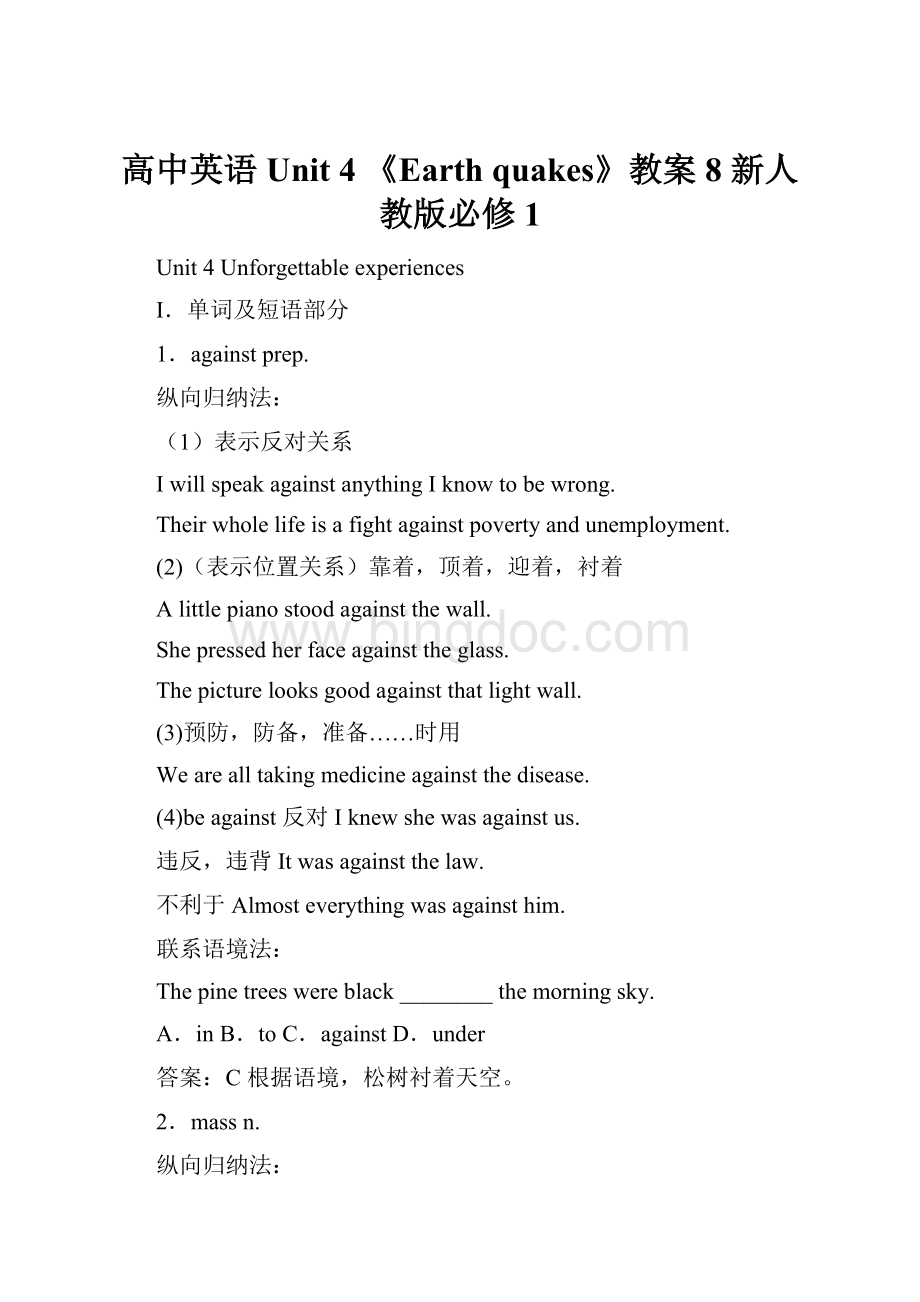高中英语 Unit 4 《Earth quakes》教案8 新人教版必修1.docx
《高中英语 Unit 4 《Earth quakes》教案8 新人教版必修1.docx》由会员分享,可在线阅读,更多相关《高中英语 Unit 4 《Earth quakes》教案8 新人教版必修1.docx(15页珍藏版)》请在冰点文库上搜索。

高中英语Unit4《Earthquakes》教案8新人教版必修1
Unit4Unforgettableexperiences
Ⅰ.单词及短语部分
1.againstprep.
纵向归纳法:
(1)表示反对关系
IwillspeakagainstanythingIknowtobewrong.
Theirwholelifeisafightagainstpovertyandunemployment.
(2)(表示位置关系)靠着,顶着,迎着,衬着
Alittlepianostoodagainstthewall.
Shepressedherfaceagainsttheglass.
Thepicturelooksgoodagainstthatlightwall.
(3)预防,防备,准备……时用
Wearealltakingmedicineagainstthedisease.
(4)beagainst反对Iknewshewasagainstus.
违反,违背Itwasagainstthelaw.
不利于Almosteverythingwasagainsthim.
联系语境法:
Thepinetreeswereblack________themorningsky.
A.inB.toC.againstD.under
答案:
C根据语境,松树衬着天空。
2.massn.
纵向归纳法:
(1)一堆,一团,一大块
Thereisamassofstonesintheyard.
(2)大量,大批
Therewasamassofchildreninthehall.
I'vemassesofworktodo.
3.usedto
纵向归纳法:
(1)usedtodosth.过去常常……(现在已不如此)
Weusedtogrowbeautifulroses.
注意:
否定句和疑问句有两种
Youusedn'ttomakethatmistake.
Shedidn'tuse(d)todoit,didshe?
Youusedtosmokeapipe,didn'tyou?
/use(d)n'tyou?
(2)beusedto+n./doing习惯于
Ihavealwaysbeenusedtohardwork.
Hebecameusedtosuchadiet.
I'mnotusedtotreatingpatientsthisway.
I'mnotusedtobeingtreatedlikethis.
(3)beusedtodo被用来做……
Thisknifeisusedtocutbread.
横向归纳法:
表示“过去常常……”时,usedto与would区别
(1)would只强调过去常常……,usedto说明现在不是如此。
Theoldwomanwouldsitthereforhoursdoingnothing.
(2)would只接行为动词,usedto可接行为动词和表状态的词。
Thereusedtobeatempleatthefootofthemountain.
联系语境法:
I________beingtreatedlikethat.
A.don'tusedto
B.didn'tusedto
C.amnotusedto
D.usedto
答案:
C我不习惯于被人这样对待用beusedtodoing/n.。
4.cutdown
纵向归纳法:
(1)砍倒
Ifyoucutdownallthetreesyouwillruintheland.
(2)减少,削减
Ihavedecidedtocutdownmysmoking.
横向归纳法:
(1)cutup破碎,切碎
Theycutdownthetreeandcutitupforfirewood.
(2)cutoff
切断,停掉
Ourwatersupplyhasbeencutoffagain.
隔绝,挡住
Thefloodscutusofffromourhomes.
使电话中断
Wewerecutoffinthemiddleofourtelephoneconversation.
(3)cut…in/intopieces把……切成碎片
Thevegetablesshouldbecutintosmallpiecesanddroppedintotheboilingwater.
联系语境法:
IsGeorgetryingtocuthisweight________?
A.off
B.down
C.up
D.through
答案:
Bcutdownweight减少体重
5.completelyadv.完全地
Theeighteenthcenturydevelopedacompletelynewkindofnovel.
纵向归纳法:
(1)completeadj.完整的,全部的;完成的
Isthisacompletestory?
Whenwilltheworkonthenewrailwaybecomplete?
(2)completev.完成
Theworkmenhaven'tcompletedthehouseyet.
(3)completionn.(不可数)完成,结束
Afterthecompletionofthejobtheworkmanwenthome.
横向归纳法:
complete与finish表“完成”时的区别
(1)complete作及物动词,只接n.或pron.
Therailwayisnotcompletedyet.
(2)finish
不及物动词
Ican'tcometillIhavefinished.
及物动词,接n.或doing
Whendidyoufinishyourcollegecourse?
Ifinishedreadingthebooklastnight.
6.strike
纵向归纳法:
(1)打,敲,击,砍,打中,击中
Hestruckmewithhisfist.
Thehousewasstruckbylightning.
(2)发起进攻,袭击
Hemovedawayastheanimalstruck.
(3)撞,触(礁)
Hisheadstruckthetableashefell.
(4)擦(火柴)
Istruckamatchandheldittohiscigarette.
(5)(某种想法法:
)忽然出现,忽然想起
Ahappythoughtstruckher.
(6)给人深刻印象(常用于被动语态)
Iwasstruckbyherbeauty.
(7)罢工
Theyarestrikingforhigherpay.
(8)(钟)敲(响)
Wewaitedfortheclocktostrikesix.
横向归纳法:
(1)hit打,敲,击,击中,射中
Hehitaballoverthefence.
Thestonehitthewindow.
使……受到打击
Thebadnewshiteveryonehard.
(2)beat连续有节奏地打,敲
Hewasbeatingadrum.
Therainbeatagainstthewindow.
(心)跳动
Hishearthadstoppedbeating.
(鸟翼)扑动
Thebirdbeatitswingsrapidlyasitflewon.
打败,打赢,取胜
Ourchampioncanbeatallrunnersinthecountry.
Thedifficultyhasbeatenhim.
联系语境法:
ItwasdarkintheroomsoRobinson________amatch.
A.struckB.burnt
C.firedD.lit
答案:
Astrikeamatch划火柴,lit是light的过去式.可以说lightafire点火,lightacandle点蜡烛。
7.handin交上去(给老师或上级),交来(handv.)
Eachstudenthastohandinacompositiononceaweek.
横向比较法:
(1)handdown传下来,传给
Ourfatherhandeddownthesecustomstous.
(2)hand…to…传给
Theywillhandthephotographtothosewhohavenotseenit.
(3)handout发给大家,散发
Theteacherhandedoutthebooksatthebeginningofthelesson.
8.seizevt.
纵向归纳法:
(1)(突然)抓住
Heseizedherhandandshookitheartily.
(2)夺取,攻占,没收,抓获
Thesoldiersseizedthecity.
Theweaponsfoundinthehousewereseizedbythepolice.
(3)(用于引申意义)抓住(机会等),理解(意思)
Shewasquicktoseizethemeaningofhiswords.
Robertseizedanopportunitytospeaktohimalone.
(4)seizeholdof(突然)抓住
Sheseizedholdofthechildandpulleditbackfromtheedgeofthecliff.
综合运用法:
________theenemyspy,soldiersreturnedtotheirstation.
A.Seizing
B.Seized
C.Havingseized
D.Havingbeenseized
答案:
C解答此题须综合运用分词知识,seize是thesoldiers发出的动作,用现在分词,又因为此题要体现出先抓住敌人,然后返回的先后顺序,故用现在分词的完成时。
9.struggle
纵向归纳法:
(1)挣扎,奋力,作努力,斗争
Theyhavestruggledforyearstofreetheircountryfromtheenemy.
Thepeoplewerestrugglingtogetoutoftheburninghouse.
(2)挣扎着走,费力地走
Thesickmanstruggledalongtheroadtohishome.
(3)struggleagainst和……斗争,搏斗
Wehadtostruggleagainststrongwindsallthewayhome.
(4)strugglefor为……而斗争
Thepoorhadtostruggleforaliving.
(5)strugglewith和……斗争
Hehasbeenstrugglingwithillnessinhislife.
Hestruggledwiththemadmantillhelpcame.
联系语境法:
Thechildrenstruggled________theheavysnow.
A.to
B.through
C.on
D.past
答案:
B联系语境,费力地在大雪中走,through表示穿过。
10.stand
纵向归纳法:
(1)站着,站起来
standonone's(own)feet/legs依靠自己,自主
Afterhisfatherdied,Johnhadtostandonhisownfeetandearnhisownliving.
standonone'shead/hands倒立
Thebeggarstoodonhisheadandsangsongs.
(2)在(某处),位于(某处),存在
Alittlepianostoodagainstthewall.
Avillagestandsatthefootofthehill.
(3)忍受,经受
HecouldnotstandthathorribleEnglishclimate.
综合运用法:
There________severalpinetreesonthesideofthehill.
A.is
B.laid
C.stands
D.stand
答案:
D解此题须综合运用Therebe句型的知识。
Therebe句型中be可用lie,stand,sit,flow等词,根据语境表示不同的意思,此题中主语是severalpinetrees,是复数,应使用are或lie,stand等,laid是lay的过去式,表放置或产卵,不符合题意。
11.fear
纵向归纳法:
(1)恐惧(多作不可数名词)
TheyhadnofearofGreatBritainandFrance.
Hisfacewasgrowingpalewithfear.
Icouldn'tmoveforfear.
忧虑,担心的事(可数)
Thereisnoreasonforyourfears.
forfearof由于怕……,以防
Heleftanhourearlyforfearofmissinghistrain.
forfear(that)惟恐,怕的是,以防
Sheworriedforfearthatthechildwouldbehurt.
infearof害怕,担心
Thethiefwasinfearofthepolice.
(2)v.恐惧,害怕接n./pron.
Catsfearbigdogs.
恐惧,害怕,接todo
Don'tfeartotellthetruth.
恐怕,担心,接从句
Shefearedthatshemightnotfindhiminhisroom.
综合运用法:
Theyspokeinalowvoice________wakingupthesleepingchild.
A.forfearof
B.incase
C.forfearthat
D.notto
答案:
A解此题须综合运用非谓语动词知识和连词知识。
B和C是连词,后接句子,D是不定式,接动词原形。
forfearof是介词短语,接动名词作宾语。
12.frightn.
纵向归纳法:
(1)惊吓,害怕(不可数)
Shewasfilledwithfrightatthesight.
(2)一次惊吓(可数)
Yougavemeafrightbyknockingsoloudlyatthedoor.
(3)infright惊恐地,害怕地
Thechildturnedandraninfrightfromthegrowlingdog.
纵向归纳法:
(1)frightenvt.吓住,使惊吓
Helefthisgunoutsidesoasnottofrightenhiswife.
(2)frightfuladj.可怕的
Itwasafrightfulstorm.
联系语境法:
Theboywas________bythenoiseoftheexplosion.
A.afraidB.nervous
C.fearfulD.frightened
答案:
Dbefrightenedby被……吓着,afraid害怕的,常用beafraidof,nervous紧张的,fearful害怕的,常用befearfulof。
13.must表示肯定推测
纵向归纳法:
(1)must+表状态的动词原形,表对现在的推测。
Themanovertheremustbehisheadteacher.
(2)must+be+doing(行为动词),表对现在的推测。
Theboysmustbereadingintheclassroomnow.
(3)must+havedone,表对已经发生过的动作或事情的推测。
Theremusthavebeenaquarrelbetweenthecouple.
Theboymusthavereadthebook.
Hemusthavestayeduplatelastnight.
注意:
must表推测时的反意疑问句
(1)对现在的推测,be(not)+主语?
Themanovertheremustbehisheadteacher,isn'the?
Theboymustbereadingintheclassroomnow,isn'the?
(2)对已发生过的动作或事情的推测。
句中有明确的表过去的时间状语,did/was(were)(not)+主语?
Hemusthavestayeduplatelastnight,didn'the?
句中没有明确的表过去的时间状语,have(has)(not)+主语?
Theboymusthavereadthebook,hasn'the?
横向比较法:
mustbedoing与mustdo的区别:
mustbedoing表示对现在进行的动作的推测。
Hemustbesleepingnow.
mustdo表示必须或一定要做某事。
Hemustdohishomeworknow.
Ⅱ.语法部分
限制性定语从句中关系代词的用法
纵向归纳法:
1.关系代词在限制性定语从句中充当的成分
主语
宾语
定语
指人
who/that
whom/that
whose
指物
which/that
which/that
whose
人和物
that
that
whose
2.如何选用定语从句的关系代词
首先确定定语从句的先行词,然后把先行词带回到定语从句中,看其在定语从句中作什么成分,根据先行词是指人指物确定关系代词。
Whereistheman________washere?
先行词是theman,把theman带回到定语从句中,构成完整的句子themanwasthere,句中theman作主语,且指人,故填who/that.
3.注意:
(1)定语从句中关系代词充当宾语时,可以省略。
(2)作宾语时,who可代替whom.
(3)whose引导定语从句时,既可指人,又可指物。
Lindalivesintheroomwhosewindowfacessouth.
Doyouknowthegirlwhosemotherisworkinginourschool?
横向比较法:
1.that与who
(1)先行词是anyone和those(指人)时,用who。
I'dliketotalktoanyonewhospeakstome.
(2)当主语是以who开头的疑问句时,用that。
Whoisthegirlthatissittingbythewindow?
(3)先行词中既有人又有物时,用that。
2.that与which
(1)用that的情况:
先行词是指物的all,everything,nothing,something,anything,little,few,much,none等不定代词。
Thereisstillmuchthatcanbeimproved.
先行词被all,every,no,some,any,little,much,neither等修饰。
I'vereadallthebooksthatwereborrowedfromthelibrary.
先行词被theonly,thevery,thelast,thenext等修饰。
HamletistheverybookthatIwanttoreadagain.
先行词被形容词的最高级修饰。
Lightblueisthebestcolourthatsuitsher.
先行词被序数词修饰。
Thefirstthingthatweshoulddoistoworkoutaplan.
前已有疑问代词时,为避免重复。
Whichofthebooksthathadpictureswasnotworthre